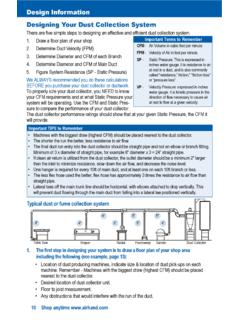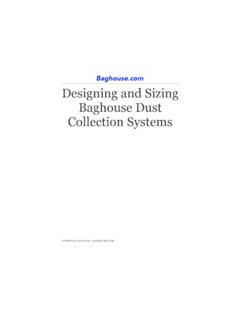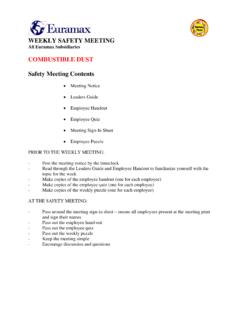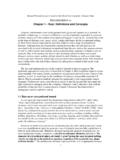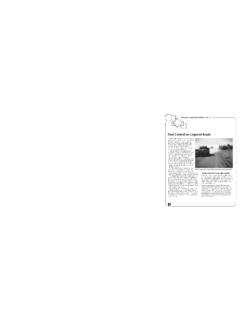Transcription of Dust Explosion Scenarios in the New CCPS …
1 1 dust Explosion Scenarios and Case Histories in the CCPS Guidelines for Safe Handling of Powders and Bulk Solids Robert Zalosh1 Stanley Grossel2 Russell Kahn3 Daniel Sliva4 Submitted for Presentation at the 39th AIChE Loss Prevention Symposium Session on dust Explosions, Atlanta, April 2005 R. Zalosh is at Worcester Polytechnic Institute, Worcester, MA. S. Grossel is at Process Safety and Design, Inc. R. Kahn is at Syngenta Crop Protection, Inc. D. Sliva is a consultant to the Center for Chemical Process Safety. 2 Abstract The new CCPS book, entitled Guidelines for Safe Handling of Powders and Bulk Solids, discusses several different types of accident Scenarios , including Scenarios that can lead to a combustible dust Explosion .
2 The dust Explosion Scenarios are divided into the following three categories: Explosions within Process Equipment, Explosion Propagation into Interconnected Equipment, and Secondary dust Explosions in Buildings. Examples of process equipment Explosion Scenarios include dryer explosions involving particulate clouds or hybrid vapor- dust mixtures ignited by overheated (often smoldering) dust layers, blender explosions ignited by either electrostatic discharge or a failed bearing, and dust collector explosions ignited either by tramp metal impact against the collector wall, by a smoldering nest from upstream equipment, or by an electrostatic discharge.
3 Explosion propagation into interconnected equipment often occurs via either pneumatic or conveyor transport ducting. Secondary explosions in buildings occur when the primary Explosion causes a breach of equipment or a weak enclosure, and the associated blast wave creates a suspended dust cloud that is ignited by the vented flame from the primary Explosion . Case histories illustrating these common dust Explosion Scenarios are described in this paper, along with a brief summary of dust Explosion assessment tests that can be conducted to make material and facility specific determinations of the most appropriate protection measures.
4 3 Introduction The new Center for Chemical Process Safety Guidelines for Safe Handling of Powders and Bulk Solids [1] includes a great deal of material on dust Explosion Scenarios , case histories, and methods for specific assessments of dust Explosion hazards. Excerpts of some of this material are presented in this paper, categorized as Explosions within Process Equipment, Explosion Propagation to Interconnected Process Equipment, and Secondary dust Explosions in Buildings. This categorization scheme often parallels the escalation of some of the more devastating dust explosions, which originate in one piece of equipment, propagate to other equipment, and finally emerge from the equipment to produce a massive deflagration in a process building.
5 In many dust explosions the originating event is either a smoldering fire or an exothermic decomposition of particulates. The new CCPS Guidelines book [1] includes detailed background and descriptions of particulate fires and decompositions, but those discussions and descriptions are beyond the scope of this paper. Explosions Within Process Equipment dust explosions occur in process equipment when there is a particulate concentration between the Minimum Explosible Concentration (MEC) and the Upper Explosive Concentration (both of which depend on the oxidant present), and then an ignition source develops or reaches the combustible cloud.
6 The types of process equipment that routinely have combustible dust concentrations in at least a portion of the equipment volume include blenders, dryers, dust collectors, and grinders/pulverizers. Table 1 lists the number and percent of dust explosions that have been reported to occur in these and other equipment in surveys performed in the [2,3], and Germany [4] during the time periods indicated. 4 Table 1 Equipment Involved in dust Explosions (FM,1985-95) + (IRI,1975-2001) (1979-1988) (HSE) Germany (1965-85) (Eckhoff, 1997)
7 Equipment # Incidents % # Incidents % # Incidents % dust Collectors 156 42 55 18 73 17 Grinders/Pulverizers 35 9 51 17 56 13 Silos/Bunkers 27 7 19 6 86 20 Conveying System* 32 9 33 11 43 10 Dryer/Oven 22 6 43 14 34 8 Mixers/Blenders > 12 > 3 7 2 20 5 Other or Unknown 84 23 95 31 114 27 Total 372 100 303 100 426 100 * Conveying systems include conveyors, ducts, and elevators. dust Collector Explosion Scenarios Three possible reasons for the high occurrence of dust collector explosions are 1) they are almost omnipresent in particulate handling facilities, 2) they inherently concentrate the smaller particles which are easier to ignite than the mostly larger particles in other equipment, and 3) dust collectors are often structurally weaker than other process equipment, and therefore more prone to Explosion damage.
8 Data from the German compilation of dust explosions indicate that the most frequent ignition sources have been mechanical sparks (41%), smoldering nests (11%), electrostatic discharges (10%), and mechanical heating via friction (7%). Matsuda and Yamaguma [5] describe a tantalum dust collector Explosion that they attribute to an electrostatic discharge in the collector. The small, corral shaped tantalum particles have a high resistivity, and become electrostatically charged by rubbing against the collector wall.
9 Apparently an electrostatic discharge from the charged particles triggered the Explosion in the 5-m high, diameter bag type collector. The following account of an Explosion in a baghouse dust collector used to collect a pharmaceutical product from a hammer mill/flash drying operation illustrates how frictional heating in 5upstream equipment can produce a smoldering nest ignition source for a dust collector Explosion . The impact hammer mill had been operating for approximately 10 minutes when the operator heard unusual grinding sounds coming from inside the mill.
10 He immediately shut down the mill just as an Explosion occurred within the dust collector, located inside the building on the second floor. The pressure wave caused the Explosion vent (a hinged panel) of the dust collector to open, and the Explosion products and unburned powder were directed outside the building via a vent duct. However, a screen had been securely fastened at the end of the duct to prevent birds from entering, and as the vent panel swung upward and outward, it struck the screen and opened no further.
